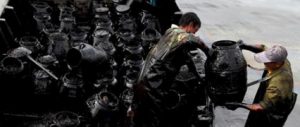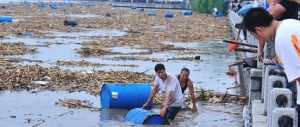Public concern has erupted in China over the handling of an oil slick in the Bohai Gulf, which has polluted an area six times the size of Singapore and raised fears for local economies reliant on fishing and tourism.
The progress of the incident – which originated in an oil field owned by US firm ConocoPhilips and China National Offshore Oil Corp (CNOOC) – from attempted cover-up to eventual exposure, shows that, while environmental awareness is growing among citizens, China’s companies and even its authorities are still thinking and reacting in the old way. Meanwhile, multinationals are adopting local practices and reminding us that China must strive to improve its systems of environmental management.
The Bohai spill started in the Penglai 19-3 oil field in early June and was brought to the attention of environmentalists and the media via microblogs on June 21. Investigative newspaper Southern Weekend published the first mainstream article on the event on June 30 and the following day CNOOC admitted there had been an incident. Four days later, the State Oceanic Administration (SOA) held a press briefing and – a month after it had first begun – the story finally became headline news.
The Penglai 19-3 oil field is a joint venture between CNOOC and the ConocoPhilips China (CPOC), the Chinese subsidiary of the US oil giant. CNOOC has a 51% stake in the field, while CPOC holds the remaining 49% and actually runs the field. These corporations were responsible for last month’s spill and will naturally have firsthand information about the incident and the emergency measures taken. Yet they were the last parties to reveal that anything was wrong.
Material gathered together from various sources indicates that a small quantity of oil started to leak into the sea at the oil field’s Platform B on June 4. This was followed, on June 17, by a small-scale accident in the oil well at Platform C. The responsible party was the operator of the oil-field, CPOC, but the company hid these incidents from the public. It was only after the maritime environmental authorities held a press conference on July 5 – to report their finding that CPOC held primarily responsibility for the leak – that the company spoke to the media and admitted the accident had occurred.
Not only did the delayed disclosure of information by the two responsible companies reek of a cover-up, but the information released was of poor quality – and actively misleading of the public and investors. According to media reports, CNOOC insiders stated on July 3 that the leak of crude oil had been brought under control, the clean-up operation was near complete and only about 200 square metres of ocean had been affected.
But, according to the results of the SOA investigation presented on July 5, 158 square kilometres of ocean were directly impacted by the oil leak. Moreover, by July 11, the cleanliness rating of 840 square kilometres of surrounding waters had fallen from grade 1 to a low grade 4, while the quality of another 3,400 square kilometres was downgraded to either grade 3 or grade 4.
At a press conference on July 6, CPOC did its best to play down the seriousness of the pollution, claiming that the first leak, which occurred on the seabed, had already been plugged. But a statement from SOA on July 13 explained that the situation was not entirely under control. CPOC’s progress in identifying and plugging potential leaks had been slow, it said, adding that its investigations had confirmed that “Oil has leaked from platforms B and C at Penglai 19-3 for a number of consecutive days, there are streaks of oil floating on nearby waters and a survey of the seabed shows there are still signs of a possible leak near Platform B.”
SOA said: “All the facts indicate that CPOC’s measures for dealing with the leak so far have been temporary and remedial, and will not completely eliminate the risk of leaks. There is a possibility of further leaks at any point, representing a huge threat to the ecology of the Bohai Sea.”
The corporate failure to be open with the public demonstrated here is, of course, shocking. But the disclosure of information by the maritime environmental authorities has also fallen short. On July 13, CPOC released a statement saying that, on the days that each of the oil-field accidents occurred, the company immediately reported the facts to the authorities. However, SOA did not hold a press conference or release the findings of its investigation until July 5, a full month after the first incident.
In response, SOA said that, following the leak, the body had “within a certain scope, reported the results of our monitoring activities”, in accordance with the relevant laws and taking account of the possible impacts. That included reporting the problems to a number of state and local government departments. SOA also stressed that monitoring, analysis and evaluation requires time, that conditions at sea were poor during the relevant period and that the incident was complex and the first of its kind in China.
But these explanations do not stand up to scrutiny. That the accident happened is an objective fact, and the potential impact on the public was clear. In line with international practice, SOA could have reported the incident immediately, at the same time as indicating that certain questions still required clarification and further disclosures would be made as soon as investigations had completed.
Following the pollution incident, the companies seem to have believed it was sufficient to inform the authorities promptly, and the authorities in turn thought it was enough to pass the information on to other government bodies. Telling the public was not on the agenda. Sadly, this was no one-off: from the contamination of the Songhua River to Zijin Mining’s toxic copper leak, companies involved in pollution disasters have tried to avoid responsibility through concealment and delay, while local governments have shown no enthusiasm for disclosure. If that is the approach to reporting accidents on densely populated land, it is no doubt worse when it comes to events in the middle of the ocean.
But, in this information age, companies and officials underestimate the desire and ability of the public to uncover the truth.
As the oil companies and the government sought to keep the issue under wraps, action from the public and the press brought the facts to the surface. On June 21, environmentalists and journalists noticed a microblog post that said: “Two wells at a Bohai oil field have been leaking for two days. I hope the leaks are controlled and pollution prevented”. The media had a lead.
After seeing that post, numerous journalists tried to contact CNOOC to no avail. But Southern Weekend didn’t give up and, after confirming the story with various sources, published a report on June 30. It was not an in-depth investigation, but it stirred public concern about pollution of the Bohai Gulf and shock at the attempts to keep the story hidden.
Four days later, 11 Chinese environmental groups, including Friends of Nature, Green Beagle and Green Han River, wrote to CPOC and CNOOC to express dismay and surprise at their alleged cover-up of the Bohai leak and to demand publication of the details of the incident and the ensuing oil pollution, as well as a public apology.
Over the following two weeks, the popular press exposed the failings of the companies and authorities to disclose information, and published commentary criticising the cover-up. Many internet users left online comments objecting to the actions of both the corporations involved and the government.
This pressure had an impact. During an interview, a CNOOC executive said: “The public have a lot of questions about the disclosure of information. Looking back at the handling of the incident, we didn’t pay enough attention to that aspect – concentrating instead on helping CPOC deal with the accident and failing to fulfill the public’s right to know. We need to review this incident and learn lessons.” Meanwhile, SOA assured the attendees of a press conference that it understood public concern over the leak, and would promptly publish a follow-up report on the incident.
Subsequent events did appear to offer cause for hope. On the morning of July 12, another accident occurred at a different CNOOC oil field in the Bohai Sea, causing a small quantity of crude oil to leak into the ocean. SOA announced the news within 12 hours and, within another 12, CNOOC had followed up with a statement on the situation. On July 13, SOA ordered CPOC to halt operations, on the grounds that work to eliminate the risk of new spills had been too slow, and required that CPOC ensure “information on the leak is promptly reported to SOA and made public”.
Those two words “made public” are hugely significant: they mark the first time a government department has urged a polluting company to disclose information on an incident of this kind. They show that, finally, the publication of environmental information has moved from being a public and media desire to a government requirement. And they demonstrate that there is a good degree of consensus within Chinese society on the concept of environmental transparency.
Even so, we must remember that there is a long way to go. When CPOC’s parent company ConocoPhilips was asked by the media if it would similarly cover-up an oil spill in the United States for a whole month, its answer was: “This incident happened in China”. Clearly, the foundations and mechanisms of open information in China remain weak. If we want to make information disclosure by business and government the norm, we need to strengthen the legally binding requirement to do so and broaden the scope for environmental litigation and other means of redress.
Only then can China make companies understand that, by reducing the risks of compensation payouts, transparency is essential to their own interests – and bring about more proactive disclosure.
Ma Jun is director of the Institute of Public and Environmental Affairs.
Homepage image from Greenpeace


